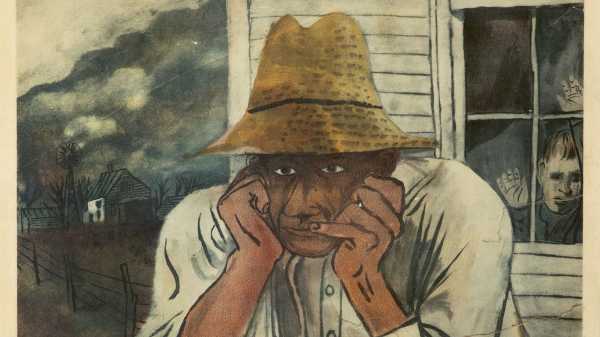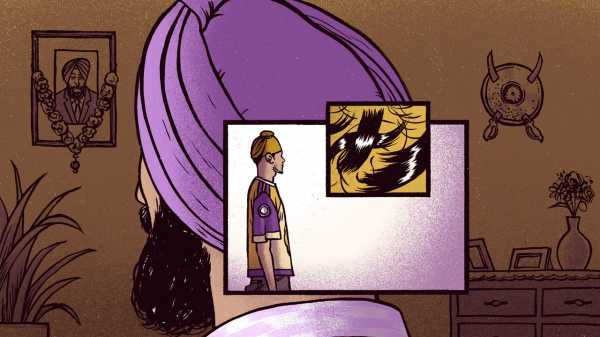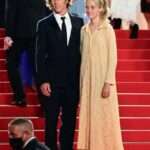
Save this storySave this storySave this storySave this story
From the late nineteen-forties through the mid-fifties, Ben Shahn was one of the most in-demand artists in America. Whether you were mailing a package at a post office, flipping through a national magazine, or watching CBS, you would have seen Shahn’s chiselled line and patchy brushwork. Corporations and private collectors were hungry for his paintings; union halls and government agencies plastered their walls with his murals and posters; and in 1947 the Museum of Modern Art crowned him with a mid-career retrospective.
You’d imagine Shahn’s work would be supremely beautiful, or at least soothing to the eye. Oddly enough, it was neither. Shahn was known as a social realist: a painter of hardscrabble life who registered every spasm and twitch of the body politic, from the Great Depression to Vietnam. In truth, he was more of an adman with leftist convictions, less interested in documenting the lives of farmers and bricklayers than in boiling down an emotion into the smallest possible unit of visual meaning—a clenched fist, a furrowed brow—and communicating that emotion to as many people as possible. According to his own Whitmanic vision, Shahn believed he could speak to the six million people who understood Norman Rockwell and to the sixty who understood Picasso’s “Guernica.” And, in some ways, he could. He was the rare chameleon who appealed to both corporate types and the working class, bean counters and art critics. Compared with other American artists who’ve managed a reputation on this scale, his closest analogue might be Dolly Parton.
“Ben Shahn, On Nonconformity,” the new show at the Jewish Museum, is the first retrospective of Shahn’s work in America since 1978. It reportedly had a difficult time finding a U.S. home after it opened, at Madrid’s Museo Reina Sofía, in 2023, and one can see why. The curators seem to have licked a finger and held it to the political winds. As the catalogue states, the exhibition intends to read Shahn’s paintings, posters, drawings, and photographs “through the lens of contemporary diversity and equity perspectives.” There’s no outpouring of new research, no bigger-than-ever assemblage of buried or forgotten work. Instead, the gambit here is to shock-paddle Shahn back to life, as an unsung national hero: a progressive who rallied to the causes of labor, civil rights, and social welfare, and whose art we should appreciate because of his exemplary politics. The mystery that the show never addresses is why people once cared so much about his art—and why we should, today.
Shahn was born in Lithuania in 1898, under the fist of Russian rule, and arrived at Ellis Island in 1906, with more than a hundred thousand other Jews from Eastern Europe. He apprenticed as a lithographer, learning to mix acid, sharpen chisels, and prep lithography stones before progressing to letters, drilling himself for months on the roman alphabet. While working on and off, he paid his way through classes at N.Y.U., City College, and the National Academy of Design, and deepened his arts education on trips to Europe and North Africa. His most important influence, though, remained lithography—its limestone and grease pencil—and the engraver’s chisel. These tools molded Shahn as a draftsman and gave him a signature style, even in his paintings. Look at almost any canvas and you can see his rough black line at work, corralling and structuring muddy splotches of paint.
The show offers no glimpse of Shahn’s apprentice years or French-modernist flailing, when he fell under the spell of Cézanne, Matisse, and Rouault, and instead begins with Shahn’s most famous piece: “The Passion of Sacco and Vanzetti” (1931-32). It usually lives downtown, at the Whitney Museum, and here it’s mounted so that it can be seen from the sidewalk on Ninety-second Street, even before you hit the security line. In 1927, Nicola Sacco and Bartolomeo Vanzetti, two working-class Italian anarchists charged with murder, were sent to the electric chair in Massachusetts, setting off protests around the world. Shahn puts the bodies of Sacco and Vanzetti at the foot of the painting, in their coffins, and above them the three members of the Lowell Committee, who affirmed the guilty verdict. The piece, as the title suggests, is a modern-day Crucifixion.
When Shahn didn’t like someone, he could paint them very well as a dead fish. The skin tones of the judges range from bruised potato to wet brown paper bag, and their bodies are cartoonishly flat. Shahn, inspired by Italian fresco, preferred egg tempera to oil, because it dried quickly and left little time for revision—forcing his hand into a decision. Though other American painters such as Thomas Hart Benton, Andrew Wyeth, and George Tooker also used tempera, Shahn’s surfaces were consistently coarser. Just look at any person in a painting by Tooker. You could drizzle olive oil on one of those arms or legs and swallow it like a noodle. With Shahn, it’s all roughage.
The Great Depression was oddly good to Shahn. Even though lithography work was hard to come by, he hung out his shingle as a painter and found representation at Downtown Gallery, by way of Edith Halpert, who exhibited his cycle of twenty-three pieces on the Sacco and Vanzetti trial to critical success and mild scandal. The rest of Shahn’s résumé from the thirties reads like that of a lefty artist plucked from central casting. He’s tapped by Diego Rivera to assist on the most infamous mural of the decade, “Man at the Crossroads” (torpedoed by Nelson Rockefeller for its inclusion of Lenin); he joins the Artists Union and edits its journal Art Front; he starts designing posters for the Resettlement Administration and goes to bat for F.D.R. and the New Deal. “Propaganda,” he said, “is a holy word when it’s something I believe in.”
The key work to emerge from this period is not a big mural commission—such as the forty-five-foot narrative mudslide of the Jewish-immigrant story housed in an elementary school in New Jersey—but Shahn’s photography, a medium he initially knew nothing about. As luck had it, he shared a studio with the great documentary photographer Walker Evans. In an interview from the sixties, Shahn recalled Evans teaching him how to shoot. “He says, ‘Well, it’s very easy, Ben. F9 on the sunny side of the street, F4.5 on the shady side of the street. For a twentieth of a second hold your camera steady,’ and that was all.” The Resettlement Administration sent Shahn on a reconnaissance mission to get to know America by car, and during three months of driving around the South, through coal and cotton country, he snapped around three thousand pictures.
Photography sculpted Shahn’s eye in a way that no other medium could. It prompted him to see the incidental as a symbol. A soiled shirt could speak to the Dust Bowl, an engorged cotton sack to the evils of slavery. Shahn used an angle finder, so that he could point the camera in one direction and take a photo ninety degrees to his left. Supposedly, this allowed him to capture his subjects “unaware,” but that’s only half true. Shahn’s best photographs show people both aware and not. The exhibition catalogue has a few excellent examples of this which have been dropped from the show, such as “Sharecroppers’ Children on Sunday, near Little Rock, Arkansas” (1935), a masterpiece of contrasts and parallels. The facial expressions of the children might as well belong to different centuries. One girl has her face twisted up in disgust. Another, with pale eyes, is stroking her chin and seems to be experiencing all of history from some Archimedean point. Remember, what we’re witnessing here are not everyday faces but faces rearranged around a stranger holding a space-age gizmo, gazing the other way.
To see the angle finder in action, you can look up Shahn’s “Self-Portrait Among Church Goers” (1939). The painting is a mini summa of two key tendencies running through Shahn’s work: self-quotation and cheekiness. Shahn paints himself, camera in hand, at the entrance of a church in Brooklyn where a sermon criticizing one of his murals had been delivered. A couple of the grumpy churchgoers standing nearby are lifted from a photo he’d taken in Natchez, Mississippi, in 1935, stitching together two times, two places, and two different media (as Shahn liked to do). His self-presentation is not that of a postmodern auteur, poised to trounce his critics, but of a goofy man off to the side with spectator shoes, spindly legs, and ginormous hands. He’s dunking on the church and its self-serious patrons—if you squint at the church sign, it reads “IS THE GOVERNMENT FOSTERING IRRELIGION IN ART??????”—but he’s also dunking on himself: the artist at the edge of the frame, at the edge of everything, always prodding and poking society with a stick.
Mr. Spectator Shoes could walk right into his own retrospective at the Jewish Museum and no one would recognize him. Lest we forget, this was an artist who made drawings of bespectacled geese and a tuxedo-wearing bird named “Mr. H. Falco Peregrinus.” For every painting of a tenant farmer is another like “Summertime” (1949), in which a man is having an overly intense experience with a watermelon, or “Epoch” (1950), with a little bald fellow doing a handstand on the heads of two cyclists, his pants scrunched up around his knees. While Shahn was certainly a political creature, with a fiery sense of moral purpose, he wasn’t a one-dimensional Homo politicus. He had wit.
In time, Shahn worried that his imagination was truncated by photography, or that people thought as much. The Second World War and the Red Scare drove him toward a quasi-mystical visual language, more Marc Chagall than Diego Rivera, that relied on a growing menu of tropes: masks, rubble, blind people, flames. The other historical force goading him on, away from social realism and toward what he called “personal realism,” was the crisis in easel painting known as Abstract Expressionism. As the story goes, Jackson Pollock stepped onto a canvas in 1947, drizzled some paint here and there, and God reached a bony finger down from the heavens and pressed it upon the scale of art history, tilting it from Europe to the United States. Almost overnight, Ben Shahn became an antique. When MOMA sent both Shahn and Willem de Kooning to represent the U.S. at the Venice Biennale, in 1954, the message was clear: Behold the past and future of American art.
Even as Shahn racked up honorary degrees and television appearances in the fifties and sixties, he produced paintings that were, for the most part, bad. There are lots of pieces like “Everyman” (1954) and “Existentialists” (1957), which serve up murky allegories of geopolitical drift. You can see Shahn trying to beat a path back to Picasso, if Picasso painted only with melted popsicles and not brushes. The rare gems from this period are Shahn’s drawings, with their bold yet stuttering line. In keeping with its political master theme, the Jewish Museum provides pencil and ink studies of J. Robert Oppenheimer, Martin Luther King, Jr., and Gandhi’s hand—with a wonderful little swirl for a knuckle—though we see none of Shahn’s quivering cityscapes and forests, his lovers embracing, his solitary figures floating in despair.
Drawings like these are not immediately useful if you’re seeking Shahn out for his political virtue. They don’t have any of the muscular purpose or control he injected into his paintings, where the order of the day was to always symbolize: to take a lowly object from reality, like a potato field or a gnarled hand, and to transform it into a glowing image around which people could assemble. This was the function of art, as Shahn argued in a series of lectures he gave at Harvard in the fifties. Shahn’s best work doesn’t need this apotheosis, though. His line can gather enough of the blood and feeling of the twentieth century just by the way it distends and contracts under the brush. It always seems to be saying, “I can’t go on, I’ll go on.” It has all the virtue of being real. ♦
Sourse: newyorker.com







